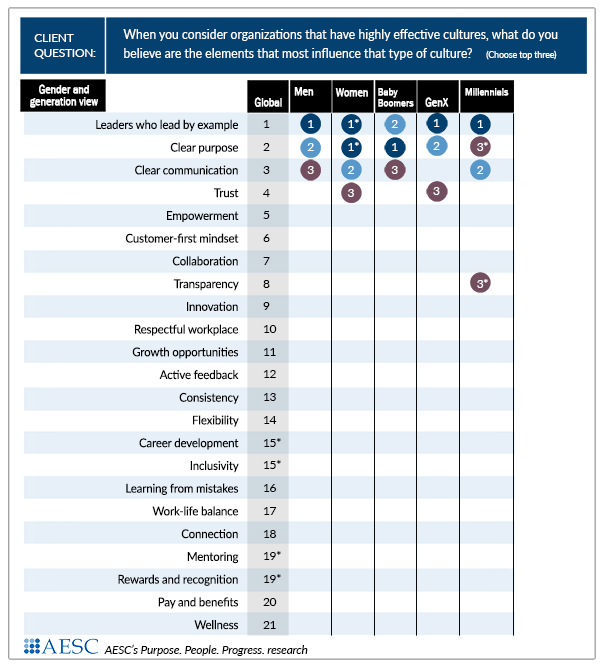
Blog
In the search for top talent, employee experience and workplace culture are as important as benefits packages and retirement contributions. What is the main contributing factor to this coveted workplace culture? Effective leadership.
Clients understand that leadership and culture are inextricably linked. In our report Purpose. People. Progress., nearly 300 C-level business leaders across the globe cite, ‘leaders who lead by example,’ ‘clear purpose,’ ‘clear communication,’ and ‘trust’ as key elements that influence highly effective workplace cultures. These four elements, when strengthened, build effective leadership skills. And, once effective leadership is established, the coveted workplace culture that top talent is looking for will follow.
Now more than ever, effective leadership is crucial.
LEAD BY EXAMPLE with CLEAR COMMUNICATION and PURPOSE
Talent is looking for authenticity in leadership. An authentic leader delivers on the promises they make and communicates in a clear direct way.
Simon Wan, Chair and Chief Executive, Cornerstone International Group, says authentic leadership “can be developed with a careful structuring of helping the leader to be self-reflective on his own self and the commitments and the visions and the value of the company. Because if the person is really authentic and truthful to his own meaning and purpose of life, if it’s also the same culture and value and missions of the company, they would really do wonderful things because the authentic leader would drive the initiative from his own heart not just because of the paycheck.”
Build Trust
Leadership built on trust can be transformational, the type of leadership that encourages innovation. This happens in two ways, by learning to listen and allowing for failure.
Your leadership can drive creativity by listening to diverse voices, creating opportunities, and accepting missteps. This practice can require a measure of self-discipline in leaders. New ideas are less likely to come from the same people whose views have always been represented.
David Colorado, Partner in Talengo/TGCL Life Science Practice says, “I think that one of the worst things in a company is that you have the decisions made only by the CEO, a committee or task force.” Diversity, he says, “is the opportunity for everybody to be free to contribute with different ideas. If you’re taking into account diversity in a company, you can have innovation when everyone is heard.”
There must be a freedom to fail and opportunities to do so. Failure tolerance is cultural, and culture also plays a role in sparking both creativity and innovation and helping it take root.
Effective leadership is a top priority and AESC Members are well-positioned to support organizations in creating a strong, diverse, innovative leadership team that can lead through a dramatic time of change. AESC is working collaboratively with our members to be leaders of change through IDEA powered leadership.
For more insights on organizational culture and purpose-driven leadership, download the Purpose. People. Progress. report.